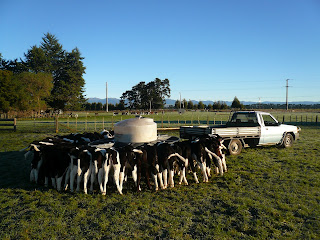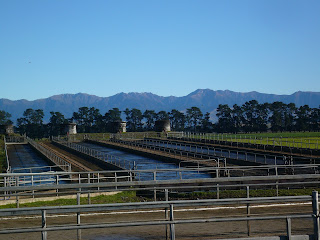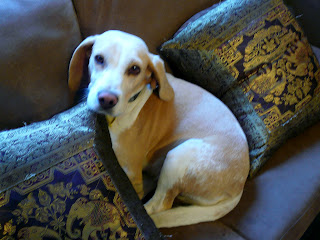This morning I was up at 4 AM and at the farm by 4:30. I
drafted all of the CIDR cows out during milking, but got a ½ hour break for
breakfast while Becs took over for me. Once milking was over, the primary
veterinarian for Ashton, Hamish, arrived to put CIDRS in all the cows I
drafted. Once all the cows were in the milking parlor, we set the parlor speed
to move slowly enough that Hamish could insert the CIDRs and Becs could give
the GnRH injections as well as call out cow numbers for me to repeat and record
them. The job only took about an hour once we got going, even though there were
181 cows!
Ashton uses a similar CIDRsynch on their non-cycling
(anovular) cows similar to the one I am familiar with with: GnRH + CIDR, 7 days
later pull the CIDR + PGF2α,
2 days after give GnRH, and finally breeding beginning the next day. Starting this
protocol today will allow for these cows to be ready to breed by the winter
mating period which begins on Monday, June 11th.
From 1-2 PM I went home for lunch and then returned to learn
how to feed calves with Becs. Calves at Ashton are fed two times per day plus
grain and kept in group pens of 18 calves in a calf shed until about two weeks
of age. Once calves drink well enough they are moved out to pasture in larger
groups of as many as 47 calves. These calves get fed up to 4 liters (1 gallon)
of milk per calf once a day. The milk calves that were born from March to May
during the fall calving season at Ashton are now only being fed once a day.
Becs filled the large, 60-nipple mob feeder full of milk
(500 liters), and we drove that down the road to the pastures to feed all
5different groups of calves, with about 30-40 calves per group. In order to
feed the calves, we would drive into a pasture and let enough milk out of the
tank for about 4 liters per calf. The calves would gather around the feeder and
drink until the milk was gone. With a little convincing, they left the feeder
to eat the grain we put out for them while they were drinking and then we would
drive off.
This is how it is supposed to go…imagine learning to feed
the calves and how to drive a stick shift truck…all while remembering to drive
on the wrong (left) side of the road. Luckily Becs was there to help me and
after I got the hang of switching gears and driving on the wrong side of the
road, feeding calves was the part I could handle the best. Tomorrow I get to
try it myself so hopefully that means Becs thinks I am capable of doing the job
alone.
Feeding calves day 1 - the manual blue Ute (truck) I learned to drive
By the time calves were fed it was 4 PM and it had been a
long day, but good, day of work. Since tomorrow is Saturday, Josh and Becs like
to keep the weekends light, so all I have to do is feed calves in the morning
and help dry off some cows.
Day 6 – Saturday, June 2, 2012
This morning I did not have to be to the farm until 8 AM to
feed the calves. Becs left me to take care of them by myself after helping me
fill the tank on the mob feeder. I drove down the road, into the first calf
pasture, and fed the calves without a problem. Unfortunately while exiting the
first pasture a handful of these calves decided to follow me and not go back
in, so Josh and Becs came to help me get them back in. After that I was able to
feed the next two pastures of calves by myself without any issues.
I only had enough waste milk to feed 3 of the 5 mobs of
calves, so I helped to dry treat 70 cows after morning milking. Once this was
complete I was able to finish feeding calves and by 1 PM I was done for the
day.
Feeding calves day 2 - all by myself!
This morning I was at the farm at 8:30 and was in charge of feeding
calves. I filled up the mob feeder tank to 500 liters of milk and
drove down the road to the pastures full of hungry calves. All of the calves
were fed and none of them got out. Success! I finished feeding by 11 AM and
after I washed out the feeder I was done for the day.
This weekend Josh and Becs have three couples of friends
they met at Massey University visiting. Tomorrow (Monday) is a federal holiday
in New Zealand because it is the Queen [Elizabeth II]’s Official Birthday, so the long weekend
was ideal for their friends to travel from all over the north island.
According to the Encyclopedia of New Zealand, the New Zealand government system is a fully independent parliamentary democracy. A Prime Minister, elected every 3 years, is the head of the government and laws are passed by majority support of members of Parliament. However, New Zealand is also a constitutional monarchy; Queen Elizabeth II of Great Britain is considered the head of state. The country was officially founded on February 6, 1840 after the Treaty of Waitangi was signed by William Hobson, other supporters of the British Crown (Queen Victoria), as well as native Maori chiefs.
According to the Encyclopedia of New Zealand, the New Zealand government system is a fully independent parliamentary democracy. A Prime Minister, elected every 3 years, is the head of the government and laws are passed by majority support of members of Parliament. However, New Zealand is also a constitutional monarchy; Queen Elizabeth II of Great Britain is considered the head of state. The country was officially founded on February 6, 1840 after the Treaty of Waitangi was signed by William Hobson, other supporters of the British Crown (Queen Victoria), as well as native Maori chiefs.
Day 8 – Monday, June 4, 2012
Since today was a federal holiday and the workers get paid
more, the farm was pretty quiet. However, as most farmers know very well, cows
do not take federal holidays. This morning it was my job to be there at the
start of milking (5 AM) to mark cows that will not be dried off this week, but
instead will be milked through the spring calving season so they can be bred to
calve for next spring's calving season (August - October). I worked until 11:30 AM and
then was done for the day.
This afternoon I was able to finish writing my article for the Bel Group's June newsletter that I was
asked to write and catch up with friends and family on facebook. Tomorrow the
plan is to dry off about 200 cows so it will be a big day back to work.
View of the feed pad from the parlo where the cows are fed concentrates, a mixture of corn silage and by-products, before milking
I cannot believe it has already been one week since I
arrived here! My hosts have been great and so has everyone else on the farm so far. They are all really interested in learning about farms in the US. Since 95% of farms in New Zealand are pasture-based, most can hardly imagine that the greater portion of farms in the US house cows in freestalls all year round and do not rely on pasture as the main feed for their cows.
Day 9 – Tuesday, June 5, 2012
This morning I drove to the farm to get there by 7:30 but
took some pictures on my short drive there because of the beautiful sunrise!
Once at the farm I helped Becs draft 150 cows from Herd 3 to
dry off. After milking was over, Josh and Becs, Sam and I, and this morning’s
milkers dry treated these cows. It took until about 1 PM but went pretty
smoothly. I stayed to help clean the parlor and holding area and took lunch at
1:30 PM.
After lunch I returned to the farm to move one cow that had
been sorted out from the cows being dry treated that needed to be moved to a
different pasture. I rode the 4-wheeler to drive her to the correct pasture and
then went home. I spent the rest of my workday (until 5:30 PM) entering cow
treatment data into the farm’s computer system from sheets of paper used in the
parlor.
This afternoon Josh and Becs had an off farm meeting so I
was able to use the computer in their home office to enter data, cook supper,
and relax. I read an interesting article on the front page of today’s
newspaper, The Domion Post, entitled “Dirty dairying laid bare.” The story
summarized how “the unlawful discharging of dairy cow effluent into waterways
or on to land has taken its toll on the environment, on farmers, and on
regional councils,” with almost 200 firms or individuals prosecuted and $3.2
million in court-ordered fines. The president of Federated Farmers in New
Zealand, Bruce Wills, admitted that increased efforts are needed to further lower
the amounts of mishandled effluent discharges, but also that regional councils
are being stricter about infractions. I found it interesting that the number of
incidences has been on the decrease since 2008 but it still can make the front
page of the newspaper. Another consideration that needs to be taken into
account, and is also addressed in the article by Bruce Wills, is that the
number of cows in New Zealand has nearly doubled from 3.4 million to 6.1
million in the last 20 years. It has been apparent in my first week here that
Kiwis care very much about their country and preserving its natural beauty.
The weather was cloudy today and rainy now, but that means
it is warmer outside. Typical temperatures so far have been in the upper 30s to
low 40s at night and then upper 50s to lower 60s during the day. The
temperature change has not been as big of an adjustment as the short days – it
is dark by 5:30 PM and the sun does not rise until 7:30 AM. At least after June
21st the days begin to get longer!
Day 10 – Wednesday, June 6, 2012
I started at the farm at 7:30 again this morning. I started
by drafting more cows from Herd 3 to dry off after milking – 185 total. Milking
was done by 10 AM and then it took until 11:30 AM to dry treat all of these
cows. Tomorrow the plan is to dry treat 200 cows but it should be the last day
for large amounts of cows. I will be at the farm by the start of milking (5:30
AM) to draft out cows from Herd 1 for dry treatment.
At 1:30 PM I returned to the farm after lunch, fed the
weaned calves some calf grain, and then helped to put the dry cows to a
specific pasture. By that time it had gotten much colder than this morning and
started to rain…and now at 6 PM it is still raining.
After putting the dry cows out to pasture I went home and
Becs and I went to town to get some farm supplies and groceries for the BBQ her
and Josh are throwing for the employees at Ashton farm to celebrate the end of
the fall calving season. By tomorrow, milking will take less time than at the
beginning of the week so having a BBQ now makes it easier for all employees to
be there.
Day 11 – Thursday, June 7, 2012
This morning was early – 5:30 AM at the farm to draft 150
cows from Herd 1 and the rest of the cows from Herds 2-4 for dry off as well.
After milking everyone worked to dry treat cows and there were 222 total! By
the time we were done it was noon and time for lunch.
After lunch Sam and I moved 160 dry cows out to a pasture in
the lot across the road from Ashton called McGreggors. In order to do this we
took 117 dry cows that were already on pasture and then sorted out 43 dry cows
from another pasture to add to the large group to make 160 cows total. We then
drove this mob down to McGreggors where they will stay for the winter until
calving this spring (August – October).
Sam and I were done around 4:30 PM; I was done for the day
so I drove back to the house and got ready for the BBQ Josh and Becs held at
their house last night for the employees at the Ashton farm to celebrate the
end of their fall (March – May) calving season. Josh grilled lamb chops,
chicken, and brats once people began to arrive. It was not a big gathering but
was nice to sit around with everyone and talk. By 9:30 PM most everyone had
left because most have to get up early tomorrow for work – including me. Good night!
Below are pictures of my host family - Josh & Becs, their dogs Wallace and Dynamite, and their thoroughbred horse, Harvey.
Below are pictures of my host family - Josh & Becs, their dogs Wallace and Dynamite, and their thoroughbred horse, Harvey.
Harvey - Becs's horse
Wallace (its a girl!)
Dynamite
A recent picture of Josh and Becs
This morning I woke up at 5:30 AM and was at the farm by
6:15 with Becs. I took over milking for Rhox and put units on all 400 cows from
Herd 2 while he helped Becs and the vet Hamish with CIDRS. CIDRS had to get
pulled out of all the cows that got them last Friday and Lutalyse was given as
well. Breeding for next fall’s calving season officially begins this Monday,
but some of the CIDR cows will come into heat Sunday. It will be a busy week!
After Herd 2 was done I was able to go feed calves. Next
week these calves will need to be weighed again to see if they are big enough
to be weaned. Calving begins mid-July so hopefully I will only need to feed one
mob of calves after the weighing. It would be nice to have some weekends off
from feeding calves before the calving madness begins!
Once I got back from feeding calves I helped Becs and
Haymish put CIDRS into 70 more cows. After that was done I was able to have the
afternoon off. Josh, Becs, and I went into town and then came home for a
relaxing afternoon since it is their weekend off.










No comments:
Post a Comment